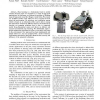161 search results - page 15 / 33 » Using EM to Learn 3D Models of Indoor Environments with Mobi... |
IROS
2006
IEEE
14 years 1 months ago
2006
IEEE
— We propose a vision-based inertial system that overcomes the problems associated with slow update rates in navigation systems based on high-resolution cameras. Due to bandwidth...
ML
1998
ACM
13 years 7 months ago
1998
ACM
To operate successfully in indoor environments, mobile robots must be able to localize themselves. Most current localization algorithms lack flexibility, autonomy, and often optim...
IJCNN
2007
IEEE
14 years 1 months ago
2007
IEEE
— In this article, we apply the competitive associative net called CAN2 to the processing of the range data of indoor environment acquired by a mobile robot, where the CAN2 is a ...
ICRA
2007
IEEE
14 years 1 months ago
2007
IEEE
— Map learning is a fundamental task in mobile robotics because maps are required for a series of high level applications. In this paper, we address the problem of building maps ...
ICRA
2010
IEEE
13 years 6 months ago
2010
IEEE
— Although robot navigation in indoor environments has achieved great success, robots are unable to fully navigate these spaces without the ability to operate elevators, includin...

